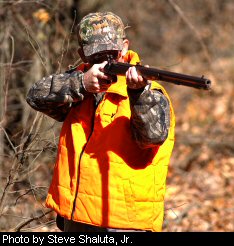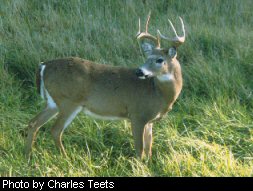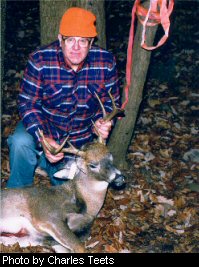

Old Bucks and Black PowderBy Charles Teets and Dave McClung
On a ridge top near the border between Virginia and “The Mountain State,” a hunter settles into his stand in the pre-dawn darkness. As the hunter waits for the first glimpse of pink light, he ponders the past. He thinks of the mountain men who settled this land. He also reflects on the great bucks, bears and other wildlife of a time long gone by. Finally, he wonders about the weapons used by early hunters in search of venison. Reflecting on yesteryears, he gently rubs the curly-maple stock of his Pennsylvania rifle. As the first ray of light silhouettes the ridge top, he awaits his chance to drop the hammer and send a cloud of smoke billowing down the mountainside. It is evident that this hunter has opted for a greater challenge than most. That challenge is Wilson Cove in the Eastern Panhandle. As light cascades across West Virginia, a chorus of gunfire follows in its wake. Hunters on the western side of the state now await their turn. In the Ohio River valley at the McClintic Wildlife Management Area, a hunter adjusts his safety harness and pulls his day pack up 18 feet to his portable tree stand locked in a large white oak. He has everything needed to stay on stand all day. As he settles in, his thoughts wander back over the events of the last several months. He recalls the scouting trips he made on the hot summer evenings in August. Closing his eyes, he envisions the large bucks with velvet-covered antlers he sighted through his binoculars feeding in a nearby soybean field. He remembers the excitement of finding large rubs and huge scrapes in late October and the close encounter he had with a Pope and Young-class buck in the pre-rut of early November. He realized long ago that great hunts can be had without firing a shot. He is jolted back to the present by the familiar sound of a deer walking in dry leaves. A single deer, probably a buck, the hunter reasons. As he strains to see the deer in the thick brush surrounding his stand, he catches a glimpse of an antler. He quickly positions himself for a shot and removes the gun's safety. As the young buck walks into a clearing only 40 yards from his stand, he smiles, glances at the arm-sized rubs below his stand, and returns the rifle to the safety position. This young six-point with the 10-inch spread is not the buck he is after. He is satisfied, however, in knowing this young buck has a chance to mature because it is not legal for harvest on the McClintic WMA.
The cove is located in the easternmost part of the George Washington National Forest. In fact, more than half the area is bounded by remote Virginia forest land. The only road entering the area is Waites Run Road. This feature has simplified the process of collecting data and surveying hunters while also making it better for law enforcement. During the fall of 1997, the DNR implemented the regulation change to allow only the use of muzzleloaders during the buck firearm season. No other regulation changes have been made. For example, antlerless deer may still be harvested using conventional firearms. The primary reason for creating such an area was to provide a unique hunting experience for smoke-pole hunters. A secondary goal was to increase the age class of bucks within the study area. After five years of muzzleloader-only hunting in the dense, rugged habitat of Wilson Cove, a buck harvested in 2001 was aged to be 8 1/2 years old. Data collected by DNR wildlife managers and biologists reveal that few bucks statewide ever reach this age.
With a good deer population found throughout the state, strategies for deer management like Wilson Cove have evolved from ideas to reality. For some, Wilson Cove offers a unique experience for a specific type of sportsman. Make no mistake -- Wilson Cove is not a trophy management area. But, if large antlers stir your passion, DNR biologists have established a niche just for you at McClintic Wildlife Management Area. Located in Mason County along the Ohio River, McClintic WMA offers 3,800 acres of the state's most fertile and diverse wildlife habitat. In 1999, DNR personnel decided that McClintic WMA would be a good location to experiment with older-age buck management. The desire to harvest older large-antlered bucks is a natural evolutionary step for many of today's hunters. Hunting magazines and videos are filled with information detailing hunting techniques and management strategies designed to grow and harvest big bucks. To reach the goal of producing more older-age bucks, antlerless hunting opportunity was increased and a harvest restriction was implemented requiring that all adult bucks killed have an outside antler spread of at least 14 inches. Most experienced deer hunters realize that the spread between the ear tips of an adult buck is approximately 14 to 15 inches and can be used to estimate antler spread of deer in the field.
During the fall 2000 hunting season, the legal harvest consisted of one buck killed with a bow and four taken during the gun season. This reduction in harvest was expected because hunting pressure because most hunters realized there would be few bucks available that met the 14-inch restriction. Hunters returned during the 2001 season, however, with more bucks available and increased antlerless hunting opportunity. Last season's legal harvest of 20 bucks included four bow kills and 16 gun kills. These are encouraging results for hunters looking for an opportunity to hunt large bucks. This antler restriction does not guarantee that all hunters who visit McClintic WMA will kill a large buck. But it does offer a unique hunting experience for hunters who are willing to pass up small bucks in hopes of bagging a mature whitetail . And remember, a great hunt can be had without firing a shot. DNR personnel realize that areas like Wilson Cove and McClintic are not for everyone. In fact, they were never meant to be. That's one reason why they are considered so special. Charles Teets is the wildife manager at the Wardensville WMA and Dave McClung is the wildlife manager at McClintic WMA. |
 The morning would be here soon; but not just any morning. For 325,000 hunters, the opening day of buck season in West Virginia is the most anticipated day of the year.
The morning would be here soon; but not just any morning. For 325,000 hunters, the opening day of buck season in West Virginia is the most anticipated day of the year.  The West Virginia Division of Natural Resources long-range deer management plan pledges to provide a diversity of deer hunting opportunities. After two years of collecting harvest data and surveying hunter attitudes, the DNR chose to designate 5,300 acres of national forest land as a “muzzleloader only” area during buck season. The area, known as “The Wilson Cove Deer Study Area” was selected because of its physical features and limited access.
The West Virginia Division of Natural Resources long-range deer management plan pledges to provide a diversity of deer hunting opportunities. After two years of collecting harvest data and surveying hunter attitudes, the DNR chose to designate 5,300 acres of national forest land as a “muzzleloader only” area during buck season. The area, known as “The Wilson Cove Deer Study Area” was selected because of its physical features and limited access.  Hunting pressure has also changed during the last five years. For instance, archery hunting has more than doubled since 1997. Hunter participation during the traditional muzzleloader season has more than tripled! As expected, some hunters have chosen other locales. Others however have made the trek from as far away as North Carolina and Florida. The enthusiasm and attitudes of hunters in Wilson Cove seem to differ from the norm. For a lot of these sportsmen, it's not all about just killing deer. It's about “The Hunt.” These attitudes can be found in hunter surveys. The surveys show that hunters now pass up more small bucks than they did prior to 1997.
Hunting pressure has also changed during the last five years. For instance, archery hunting has more than doubled since 1997. Hunter participation during the traditional muzzleloader season has more than tripled! As expected, some hunters have chosen other locales. Others however have made the trek from as far away as North Carolina and Florida. The enthusiasm and attitudes of hunters in Wilson Cove seem to differ from the norm. For a lot of these sportsmen, it's not all about just killing deer. It's about “The Hunt.” These attitudes can be found in hunter surveys. The surveys show that hunters now pass up more small bucks than they did prior to 1997.  Harvest data indicates that the 14- inch restriction protects 99 percent of all one-year-old bucks and 60 percent of the two-year-old age class. Prior to 2000, the first year of the harvest restriction, hunters harvested 60 to 70 adult bucks annually on McClintic WMA.
Harvest data indicates that the 14- inch restriction protects 99 percent of all one-year-old bucks and 60 percent of the two-year-old age class. Prior to 2000, the first year of the harvest restriction, hunters harvested 60 to 70 adult bucks annually on McClintic WMA.